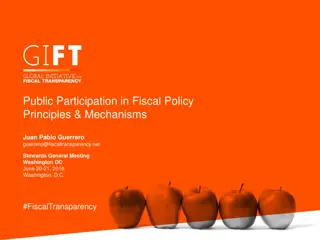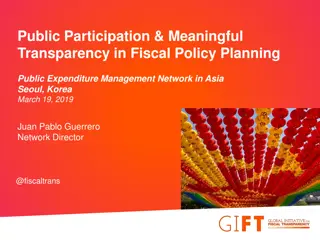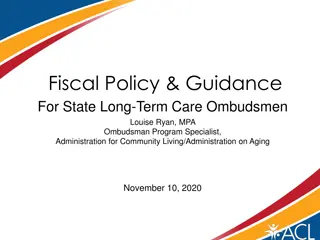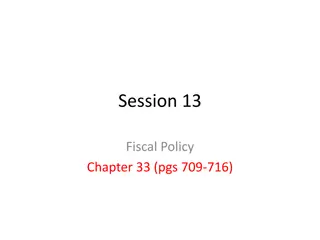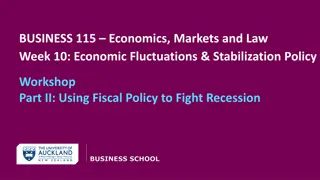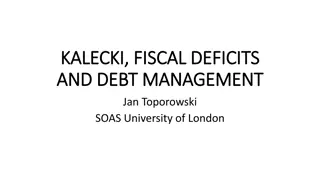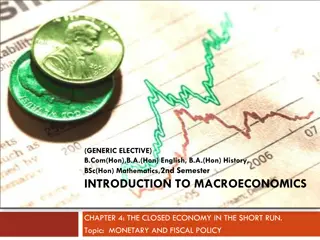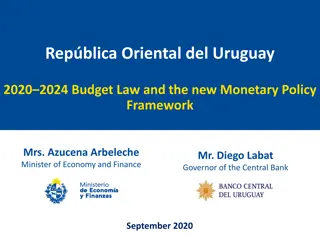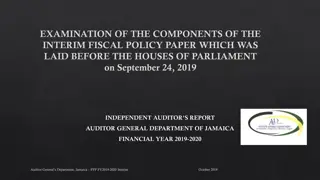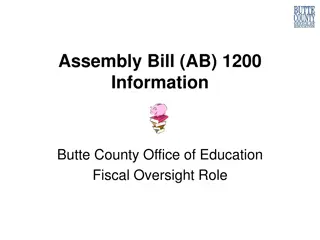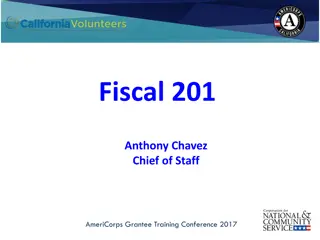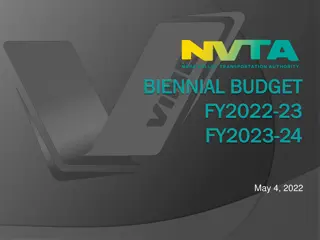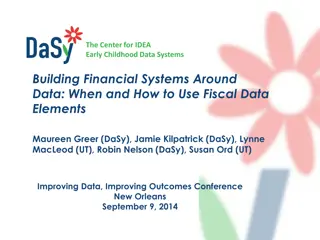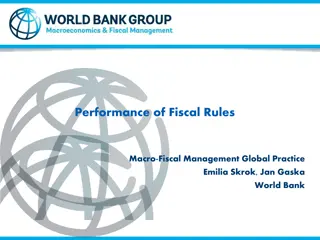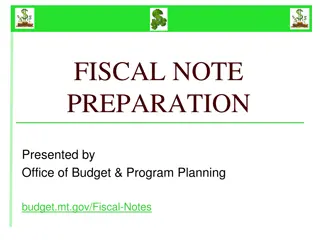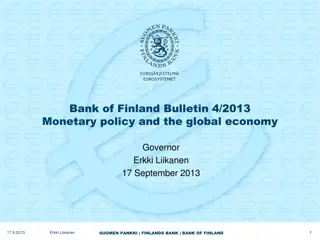Multipliers and Fiscal Policy Responses to COVID-19
Explore fiscal policy responses to the COVID-19 pandemic, apply fiscal policy multipliers, understand Marginal Propensity to Consume (MPC) and Save (MPS), factors affecting MPC, and its relationship with government spending. Review how Fiscal Policy impacts sustainable growth, stable prices, and employment goals by adjusting government spending and taxes for economic stability.
Download Presentation

Please find below an Image/Link to download the presentation.
The content on the website is provided AS IS for your information and personal use only. It may not be sold, licensed, or shared on other websites without obtaining consent from the author.If you encounter any issues during the download, it is possible that the publisher has removed the file from their server.
You are allowed to download the files provided on this website for personal or commercial use, subject to the condition that they are used lawfully. All files are the property of their respective owners.
The content on the website is provided AS IS for your information and personal use only. It may not be sold, licensed, or shared on other websites without obtaining consent from the author.
E N D
Presentation Transcript
Multipliers and Fiscal Policy Responses to COVID-19 Multipliers and Fiscal Policy
Objectives Evaluate fiscal policy responses to the COVID-19 pandemic Apply fiscal policy multipliers Multipliers and Fiscal Policy
What to do with $100? If someone gave you $100, how much of it would you spend? Think about what you would spend it on Write/Type your answer [number between 0 and 100] How does your answer compare to your classmates? Multipliers and Fiscal Policy
MPC and MPS Marginal Propensity to Consume (MPC): proportion of additional income that is spent on goods and services If MPC = .7 then consumers would spend 70% of additional income, and save the rest Marginal Propensity to Save (MPS): proportion of additional income that is saved All additional income is either spent or saved, so MPC + MPS = 1 Multipliers and Fiscal Policy
MPC Factors MPC will be higher for those with Lower income Lower taxation level More consumer confidence Multipliers and Fiscal Policy
MPC and Fiscal Policy When the government spends money and/or cuts taxes to help us recover from a crisis, there will be a multiplying effect which is influenced by the size of the MPC Multipliers and Fiscal Policy
Fiscal Policy Review Who: President and Congress What: Government Spending and/or Taxes Why: Dampen business cycle Macroeconomic goals are sustainable growth, stable prices, and full employment How: Changing government spending and/or taxes shifts aggregate demand Expansionary: increase G and/or decrease taxes AD increase economic growth and inflation Contractionary: decrease G and/or increase taxes AD decrease economic decline and disinflation Multipliers and Fiscal Policy
COVID-19 Economy Economic Growth, according to BEA.gov Unemployment, according to BLS.gov Multipliers and Fiscal Policy
Time for Fiscal Policy? Economic decline and rising unemployment while inflation never got over 1% a good time for Expansionary Fiscal Policy? Multipliers and Fiscal Policy
COVID-19 Fiscal Policy Coronavirus Preparedness and Response Supplemental Appropriation - 3/6/2020 $8.3 billion Treatment and vaccine research Testing Families First Coronavirus Response Act - 3/18/2020 $192 billion Delay tax filing deadline Paid leave if: sick, caring for someone sick, child care closed, etc. Multipliers and Fiscal Policy
COVID-19 Fiscal Policy [2] Coronavirus Aid, Relief, and Economic Security (CARES) Act 3/27/2020, amended 4/24/2020 $2.5 trillion (10% GDP) Small business loans/grants Large business loans Stimulus checks Expanded unemployment Multipliers and Fiscal Policy
Limits of Fiscal Policy Effective fiscal policy is Timed Targeted Temporary [7 min] https://mru.org/courses/principles-economics-macroeconomics/ fiscal-policy-limitations Multipliers and Fiscal Policy
Timed Recognition lag Takes time to calculate macro stats and quantify the size of the gap Administrative lag Difficult for president and congress to agree, especially if different political parties Implementation lag Economy does not begin to grow until people receive and spend Multipliers and Fiscal Policy
Temporary Too much expansionary fiscal policy contributes to national debt https://www.usdebtclock.org/ Assistance should help with recovery while maintaining market incentives Multipliers and Fiscal Policy
Targeted Target benefits toward those that are hurt most by the crisis those in most financial distress Individuals with the largest MPC in order to have the largest impact on the economy Multipliers and Fiscal Policy
Multipliers Government spends $100. If MPC = .8, you spend $80 at stores $64 spending If MPC = .5, you spend $50 at the store $25 spending When the MPC is higher (.8 > .5), fiscal policy has a larger multiplying effect ($244 > $175 after just 3 rounds of spending) Multipliers and Fiscal Policy
*G Multiplier Calculation Government spending multiplier = 1/(1-MPC) Larger MPC Larger multiplier If MPC = .8 G multiplier = 1/(1-.8) = 1/.2 = 5 G increase $1 mil Y increase $5 mil If MPC = .5 G multiplier = 1/(1-.5) = 1/.5 = 2 G increase $1 mil Y increase $2 mil Multipliers and Fiscal Policy
*Tax Multiplier Calculation Tax multiplier = -MPC / (1-MPC) Larger MPC Larger multiplier If MPC = .8 Tax multiplier = -.8/(1-.8) = -.8/.2 = -4 Taxes decrease $1mil Y increase by $4 mil If MPC = .5 Tax multiplier = -.5/(1-.5) = -.5/.5 = -1 Taxes decrease $1 mil Y increase $1mil Multipliers and Fiscal Policy
Multipliers Increasing G and/or cutting taxes increases aggregate demand in the economy. The multiplier causes further increases in aggregate demand. These cause the economy to expand. Getting money in the hands of people who will spend it (higher MPC) will result in a bigger bang for your buck (larger multiplier). Multipliers and Fiscal Policy
Policy Multiplier Estimates Multiplier is estimated by the one-year dollar change in GDP for a given dollar reduction in federal tax revenue or increase in spending. Multipliers and Fiscal Policy
In-class Activity In small groups Read the policy proposal summaries Evaluate each policy based on the four factors Individually Choose the most effective policy and explain Multipliers and Fiscal Policy
Wrap-up Which policy do you think would be most effective? 1. PPP 2. FPUC 3. Liability Protection 4. State Gov Aid 5. Meals 6. Stimulus Checks Multipliers and Fiscal Policy




